Rose is the queen of the garden. It depends on the skill of the gardener whether the bush will delight with its flowering next year. The preparation of rose bushes, regardless of the variety and frost resistance, begins in advance. At the end of August we stop cutting flowers and watering, which will promote the ripening of new shoots, and therefore a better wintering.
Queen of Flowers – preparing for winter
Do I need to cover roses for the winter?
Today the market is saturated with such a variety of rose bushes that it is difficult to make a choice. Breeders have made every effort so that in any garden, with any climatic conditions, people can see and enjoy the beauty of these extraordinary flowers.
Advice! If you don’t want to burden yourself with unnecessary work, choose varieties with high winter hardiness, such as:
Polyanthus roses : Orange, Triumph, Border King, Rothe Teschendorf;
Floribunda : Alen, Zorina, Flame of the East (red), Display (pink), Starlit (yellow), Iceberg, Diagram, Shpet (white);
Park Roses : Martin Frobisher, Ferdinand Pichard, Remi Martinre, John Franklin.
Some of the most winter-hardy varieties are considered to be: Emily, Polar Star, Gallant, Midsummer, Queen Elizabeth, Golden Celebration.
Carrying out pruning

An important stage in preparing rose bushes for winter is pruning roses in the fall. A few shoots remaining after pruning are easier to withstand a cold winter than a whole bush. Plants that were left to overwinter entirely were subsequently weakened and often susceptible to disease. It should be carried out in compliance with certain rules so as not to harm the flower.
The optimal time for pruning is the third ten days of October. It is advisable to carry out the procedure in dry, sunny and windless weather.
Prepare tools in advance: sharpen pruning shears and a hacksaw, which is used for the thickest shoots.
After carefully examining the bush, you must be sure to trim off all the upper parts, which may be susceptible to bacterial diseases. If there are small unopened buds on the plant, they are also pruned, like diseased branches.
It is necessary to cut out young stems that are not woody. It is these shoots, if left, that can rot and then infect the entire bush with fungal diseases.
So, the strongest, most powerful and well-developed shoots are left for the winter. It is enough to leave 3 to 5 shoots for the winter, trying to ensure that they are evenly spaced.
Growing garden roses: pruning
Video “Pruning and covering roses for the winter”
Rules for pruning roses for the winter
Inexperienced flower growers often ask the question, how to prune roses for the winter? Experts distinguish the following types of rose pruning for the winter:
- Short.
For polyantha (multi-flowered, forming a strong bush) roses, short pruning is used. The shoots are removed almost completely, leaving only the base for the winter (2-3 cm from each shoot). At the same time, make sure that dormant rose buds also remain (2-3 per bush).
- Average
For hybrid tea roses, medium or moderate pruning is used. Weak shoots are removed completely. The height of the woody shoots left is 25-30 cm, the number of dormant buds on them is 4-5.
- Long
When preparing park, English and Bengal roses for winter, long or gentle pruning is performed. The same type is suitable for tall hybrid tea roses. In this case, only a third of the stem is removed, leaving 8 to 10 buds on the remaining part. Regardless of the method, when pruning, an oblique cut is made over a bud that has swollen but not sprouted. The distance between such a bud and the cutting site is from 0.5 to 1 cm. Pruning is completed by processing the shoots left for the winter. To do this, use any available disinfectant. After processing, the rose bushes are hilled and the next stage of preparation is moved on - covering the roses.
How to feed and treat roses before covering them for the winter
Before insulating the roses for the winter, do not forget to carry out the last fertilizing.
Before the onset of cold weather, the roses are hilled up to 15-20 cm, adding peat or loose soil. In October, cut off all leaves, and cut weak and affected shoots to the ground. Trim all healthy shoots to a height of 40-50 cm.
Before you insulate your rose garden for the winter, you should take the time to give the bushes the final fertilizing. Roses are lovers of ash; it contains all the minerals necessary for bushes (sprinkle 200g of ash around the bush). As an option, organic matter in the form of humus or compost (2-3 kg) is added to each bush; this will serve as additional insulation against the winter cold.
To survive the winter well, bushes will need phosphorus and potassium to strengthen their immunity. Take 20g of superphosphate, 20g of potassium salt per bucket of water. Ten liters is enough for 2 bushes or apply dry under the bush.
As an option, it is possible to use special complex fertilizers for autumn feeding of roses. The main thing is that they do not contain nitrogen, which promotes plant growth.
Preparing the rose garden for winter
Stop feeding
You need to start preparing plants for the winter period from the end of August. This is the time when you should stop the rapid growth of plants by stopping watering and fertilizing with nitrogen fertilizers. It is only allowed to occasionally add a little potash fertilizer so that the trunk and branches become lignified faster.
We don’t loosen the soil
With the beginning of September, they stop all loosening of the soil layer around the bushes, so as not to provoke the growth of young shoots. This will protect dormant buds from awakening, especially if the temperature in September resembles summer.
We carry out pruning
A prerequisite for successful wintering of roses is their pruning. Only climbing and park varieties do not require it. The branches should be cut to the height of the future shelter so that the entire bush can be hidden. Cut out all the greenery (leaves and young shoots), because they won’t withstand frost anyway, and slightly shorten the woody parts.
Cleaning up the trash
From under each bush, remove accumulated debris, such as dry leaves, grass, etc., to avoid fungal diseases, the spores of which like to settle in such places.
We process the bushes
To strengthen the immune system and increase the resistance of bushes to moisture, spray roses with iron sulfate or Bordeaux mixture.
We spud every rose
To improve aeration of the root system, it is necessary to hill up the roses after spraying, raising the soil by about 20 cm. In winter, loose soil retains a lot of air, which prevents frost from getting to the roots.

Hilling up the bush will create good aeration, which will become a barrier to frost.
How to cover a climbing rose for the winter
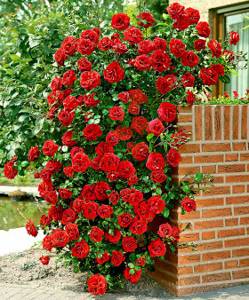
A climbing rose is a decoration for any garden. If you have a frost-resistant variety, there are no problems, but in other cases you will have to make an effort.
To begin with, shorten very long lashes, but no more than 1/3 of the length. Remove all new shoots, leaves, broken and unnecessary branches. Sprinkle the damaged areas with crushed coal. You can cover climbing rose bushes in various ways, here are some of them:
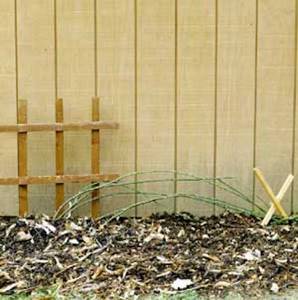
- Remove the lashes from the support or arch. Tie them together with twine, several at a time. If the lashes are flexible, roll them into a ring. Make a pillow from spruce legs and place the lashes on it. Cover the top with spruce branches, and then cover the spruce branches with covering material, securing along the edges. It is better to use spunbond as a covering material.
- Climbing rose bushes are covered using the so-called air-dry method. After pruning, removing leaves and damaged branches, remove the lashes from the arch, tie them several pieces with twine and secure them, carefully lay them on the ground. Next, from any available material: boards, plywood, boards are made in the form of a house. Cover the top with covering material or roofing felt. Until stable frosts set in (down to -5), keep one side open. Calculate the height of the “house” based on the height of your bush. With the arrival of persistent cold weather, close the house completely.
Types of shelter for different varieties of roses
For any type of shelter that you choose, a prerequisite for good wintering must be an internal air layer, i.e. The rose and the material should not be in close contact. This will protect the bushes from damping out at the end of winter, when prolonged thaws begin. If the shelter covers the branches too tightly, the normal supply of oxygen is disrupted, and the plant “suffocates.”
Air-dry shelter: for hybrid tea varieties and floribunda
Of the many options, gardeners prefer an air-dry shelter, which maintains a constant temperature (up to -4?) and is well ventilated. The covering order is as follows:
- We weave a frame 60 cm high from metal rods or wire.
- We use it to enclose a bush in the form of a cone.
- We stretch the insulation over the metal. You can cover roses for the winter with lutrasil, glassine, cardboard, etc. We fix the material to the frame with twine.
- We cover the created “house” with polyethylene, which will not allow precipitation and moisture inside.
- From below we fill the entire film with soil.
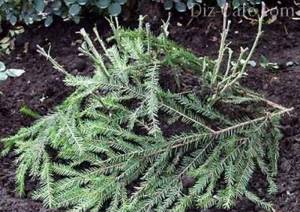
If you cover each rose with spruce branches, then rodents will not be attracted to the branches and trunk
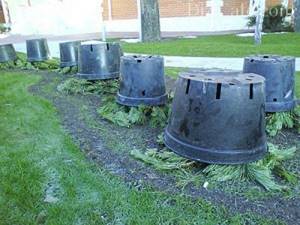
Instead of a frame, you can cover the bushes with containers with holes, and after frost sets in, cover them with film
In addition to roses, conifers are also covered with lutrasil and structures with it:
Shield cover: for climbing roses
Climbing roses remain with leaves longer than other varieties, so from the moment stable cold sets in, you need to cut off all the foliage along with the petioles. Otherwise, they may rot in winter and transmit the infection to the kidneys.
The order of work is as follows:
- We tie the prepared bush into a bundle and bend it in the direction where the branches stretch.
- We spread the spruce branches on the ground (it will protect the lashes from rodents) and lay the bush on top.
- We pin it in several places with bent wire to press it to the ground.
- We knock down 2 wooden shields: length = the length of the bush, width – about 85 cm.
- We place shields over the bush in the form of a house, and so as not to go around, we strengthen it with pegs, driving them into the ground.
- We cover the house with polyethylene, completely covering the ends and filling the film with soil on all sides. (If the ground under the bush has not yet frozen, then lift the film at the ends, and after the onset of stable cold weather, close it).
- If the winter turns out to be warm, then the corners of the ends are opened slightly to improve ventilation.
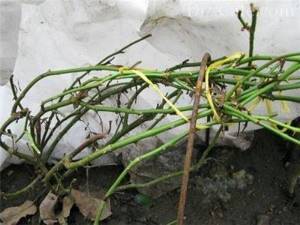
The branches are placed on the ground in the direction in which they themselves bend. This will prevent the bark from cracking
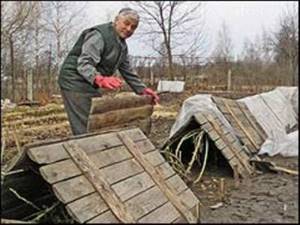
If you drive wooden pegs into the ground, they will prevent the shields from sliding under the weight of the snow.
Shields protect climbing roses growing in rows. But if the bush is located in the center of a flower bed, and other plants winter around it, then heavy shields can damage them. In this case, the following shelter for the winter is made for the climbing rose:
- The tied lashes are not placed on the ground, but are fixed with a post, nailing several pegs nearby and tying the plant to them.
- A pyramid frame is made of metal and placed around the plant so as to avoid contact with the branches.
- Fiberglass is laid on top, tied together with twine and sprinkled with soil underneath. It will not allow frost inside and will provide excellent ventilation.
- If there is no fiberglass, stretch spond or other non-woven fabric, and polyethylene on top (don’t forget the ventilation vents, otherwise the bush will dry out when it warms up!).
How to cover a bush rose for the winter
Preparing a bush rose for winter should begin at the end of August, after the last pre-winter feeding with phosphorus-potassium fertilizer. Next, in the first ten days of September, remove all the lower leaves from the roses. In mid-October, carry out sanitary pruning: remove only damaged and diseased parts of the plant, as well as the remaining foliage. Treat shrubs with bactericidal agents. And only when the constant temperature drops to -5 degrees do we begin to cover the bushes for winter.
The most reliable method is air-dry. With this method, the roses have enough air and a fairly dry climate is maintained. This method is good for a compact rose garden. Along the perimeter of the planting area, a frame of boards is placed in the form of a lattice. The top is covered with covering material. At the ends, we first leave our structure open, and with the onset of stable frosts we cover it with covering material or roofing felt.
If the rose bushes grow separately, make a wire frame in the form of a cone. Insulate the top with covering material, sprinkling sand around the perimeter. The main thing is that the branches do not come into contact with the metal.
What time should work begin?
Having figured out how to prepare roses for winter and completed all the necessary procedures, we begin to expect stable cold weather. This will happen sometime in mid-October. You should not cover roses for the winter ahead of schedule.
Recent Entries
5 working ways to use tar in the garden 7 indoor plants that help you get married even in adulthood Indoor plants that can bloom in trouble
The signal to begin covering work should be stable subzero temperatures (about -6), which will last a week or more. In the southern regions, winter may linger a little, so wait it out.
Remember: it is better to hide your plants a little later than prematurely. Light frost is not scary for shoots. It will only harden the roses and speed up the ripening of the branches. But premature sheltering will provoke the growth of young shoots and awaken the buds, which, of course, is not at all necessary for the winter. Be sure to keep in mind that when you decide to cover your roses for the winter, the weather must be dry. If it rained or wet snow before, wait a couple of days until the soil under the bushes dries out, because excess moisture can provoke various fungal infections, and in a closed mode the plants will quickly catch the disease.
In addition to covering roses for winter, you can simultaneously carry out a number of other autumn works in the garden:
How to cover a standard rose for the winter
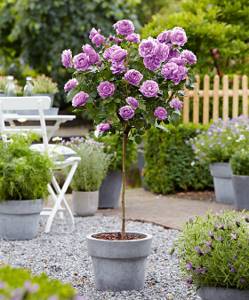
One of the most luxurious varieties of roses, differing in its shape. It’s as if they put one bouquet of roses in a vase. Standard roses need shelter for the winter, but first we prepare the bush for wintering.
At the end of August, be sure to fertilize with potassium and phosphorus. In the second ten days of September, we remove all leaves and buds. We cut out the grown shoots and extra branches inside the bush. Hill up the bush to a height of 20cm. If the bush is young, then we bend it to the ground to build a shelter. With an older bush you will have to spend more time. First, decide in which direction you will tilt it so that the barrel does not break. Be sure to tilt towards the scion. Next, gradually, not immediately, we bend the trunk and fix it with staples so that the rose does not take a vertical position again. And so on every day until the crown reaches the ground. At the base of the root, under the fold, place a small block. Insulate the crown from below and above with spruce branches, and then cover the entire plant with covering material.
Most often, the “queen of flowers” is covered as it grows. The top is wrapped in spruce paws, tied with burlap, and the bottom is covered with compost. This wintering method is not suitable for very cold winters.
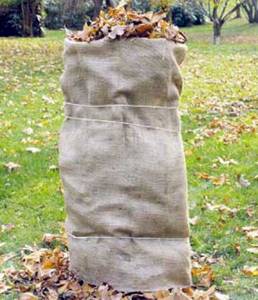
Step by step guide
First stage: preparation
Before winter, it is necessary to take protective measures for roses.
- Nitrogen fertilizing, which provokes shoot growth, must be stopped at the end of summer. You can fertilize with potassium mixtures; they help the roots become woody. The last feeding of the season can be applied in September (if it is warm, then at the end of September).
During flowering, the plant is depleted, nutrient reserves from the soil are consumed. Therefore, special fertilizers must be applied in the fall so that the plant does not gain green mass, but prepares for frost.
- For 10 liters of water you need to take 16 g of potassium monophosphate, 15 g of superphosphate or 10 g of potassium sulfate, 25 g of superphosphate and 2.5 g of boric acid. Apply 4-5 liters of the resulting fertilizer to each bush.
- The popular method of feeding is banana peels or wood ash (3 liters of jar are needed per 1 sq. m.). This composition contains a sufficient amount of potassium and calcium.
- Complex fertilizer “Autumn”, which was created specifically to prepare the roots of roses for winter.
- The bushes are also treated with fungicides, Fitosporin-M or a 5% solution of copper sulfate.
- Before covering roses, they must be completely ripe. Approximately 3-4 weeks before covering, you need to stop cutting flowers for bouquets. This rule applies to young roses that were cut for the first time this year. They must bloom, thereby naturally ending the growing season.
Advice! After pruning, roses must be treated with a disinfectant. The bushes are hilled to a height of 30 cm. After this, the roses are ready for shelter for the winter.
- Different varieties of roses have different periods of leaf fall. But be sure to pick or cut off all the leaves. This will put the plant into a dormant state and reduce the risk of infection.
- To disinfect the above-ground parts of the bushes, it is necessary to treat them with a solution of iron sulfate or a fungicide before covering them. The ground under the bushes should be cleared of debris and weeds.
Watch the video! How to properly cover roses for the winter
Second stage: trimming or bending
Park and climbing varieties of roses do not need to be pruned. Some bush varieties and climbing species that are sensitive to cold must be gradually, 3-4 weeks before sheltering, placed on supports that go lower and lower, so as not to damage or break the woody stems. This must be done gradually and carefully.
Park roses - bend or prune?
Here opinions are divided. Some people leave roses for the winter without pruning so that they can withstand it better. Such a plant will wake up earlier in the spring and it is unlikely that new shoots will be released. But there is a flip side to this coin: the smaller the above-ground part of the bush, the better it will withstand frost. In addition, leaving the top parts of the stems increases the risk of bacteria development. Therefore, it is still recommended to do pruning.
The presented photo shows four stages of insulation of stamped roses. The roots are dug up if the trunks bend poorly. The leaf part is covered with spruce branches or dry leaves, and the top is covered with lutrasil.
How to bend rose bushes correctly?
- Dense and inflexible stems are bent in several stages, as mentioned above. You can use old construction pins or rods. This material bends easily, goes into the ground well and can last for more than one year.
- In order for the bush to become mobile and bend over without damaging the plant, you should carefully dig up with a pitchfork two or three times. At the same time, do not dig it up too much.
- If the bush has been grafted, it should bend towards the graft. This is done so as not to break the stem from heavy load.
Stamped and climbing roses are removed from the supports and laid on the ground.
Watch the video! Pruning and covering roses for the winter
Third stage: covering
How and what to properly cover roses for the winter ? There are two types of cover: air-dry or wrap.
- It is necessary to dig in this way: the prepared bushes are covered with soil to a height of 20-40 cm of the stems. The upper shoots are completely covered with dry leaves. Or roses are completely buried in the ground;
- The air type of shelter is the insulation of the roots with leaves or spruce branches, and the above-ground part with a structure made of any materials: plywood or plastic;
- There is an option for wrapping roses; for this, a heat-insulating material is used, for example, geotextile fabric.
Features of different types of shelter
Experienced gardeners give advice on covering various types of roses for the winter.
- Climbing rose . The stems of this species are not pruned for the winter. Healthy shoots are pinched, and only diseased shoots are cut out. You should be careful with long rose loops that are covered with soil. For them, you should carefully prepare a place, pour a layer of sand and a layer of spruce branches on top. The lashes removed from the support are carefully placed on this pillow. They put another layer of spruce branches on top of them, and a film on top.
There is another option for insulating climbing roses. A rope is made from lashes, which is placed on a prepared wire frame. A protective frame is made of wood or lutrasil over them, and the top is covered with film.
- Park roses . Most varieties of this species are frost-resistant. But young bushes should be covered for the winter. If the winter is predicted to be cold and severe frosts are expected, then you can cover the park rose using the dry method or digging.
- Hybrid tea rose . For this species, standard hilling or frame will be good protection from low temperatures. And the use of spruce branches as an addition will make winter more comfortable for tea roses.
Watch the video! Bending and pruning climbing roses
How to cover a park rose for the winter
As a rule, park varieties of roses are quite unpretentious in care and frost-resistant plants. Preparation for wintering is carried out like most roses.
In the second ten days of September, you should fertilize each plant with 20 grams of superphosphate and potassium sulfate, having previously dissolved it in 10 liters of water. From the end of September, all leaves, as well as young shoots, begin to be gradually removed. In October, we add 2-3 kg of compost under each bush. Park varieties of roses require minimal insulation for the winter; they tolerate cold well, but to be safe, rose bushes are hilled to a height of 20-25 cm, sprinkled with peat, and then covered with spruce branches. On top of the “made fur coat” use a covering material, which should be sprinkled with a little sand so that the structure holds up in strong winds.
What is better, a purchased or self-made shelter?
You can buy a ready-made shelter at any specialized place. You will have to spend money, but you will be confident that the purchase will not let you down, because it was made specifically for such procedures.
Building a shelter yourself is economical . But this requires more knowledge and skills. In addition, not everyone has covering materials such as sand, sawdust or peat on their property.
Covering roses ahead of time can cause the death of the plant! The optimal temperature for the onset of action is -5 degrees.
How to protect plants with spruce branches?
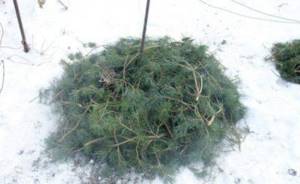
One of the most popular shelters is spruce branches.
Pros of spruce branches:
- Excellent air gap.
- Snow delay.
- Thorny branches repel rodents.
- UV protection.
Minuses:
- The likelihood of plants being infected by pests living in the needles. The yellow needles on the branches will tell you about them.
- If you collect spruce branches from living trees, there is a high probability of fines for causing damage to nature.
- Slight acidification of the soil due to falling branches.
How to cover:
- Loosen the soil to 5 mm.
- Remove weeds without touching the roots of the roses.
- Treat the bushes with antifungal agents.
- When the air temperature reaches -5 degrees, hill up the bushes and cover them with spruce or pine branches on top.
We invite you to watch a video on how to protect roses in winter with spruce branches:
Is it possible to cover flowers with sawdust if there is no spruce branches?
Their main advantage is thermal insulation.
Disadvantages of thermal insulation:
- Humidity. If the snow melts, the sawdust here will absorb water and become covered with a frozen crust. And it doesn't let air through at all. An excellent breeding ground for bacteria and mold.
- Soil acidification. Roses prefer a neutral environment.
- If sawdust is not extracted in natural conditions, for example, from furniture, then it is probably treated with chemicals against pests.
How to cover:
- Loosen the soil under the rose bush.
- Hill up the plant a little.
- Place bags filled with sawdust close to the trunk of the bush in a circle. Preferably in two layers.
- Build a frame on top and cover with film.
Can sand be used?
Sand uses it not as an independent means for buildings, but as an additive.
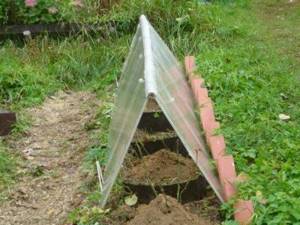
Pros of self-building:
- Sand is available, it is everywhere.
- Absorbs moisture well.
Cons : sand remains wet for a long time and dries very slowly.
How to cover:
- Tie the roses together with twine.
- Trim the branches a little.
- Cover the base with dry peat.
- Sprinkle sand on top almost to the very tops.
- Then build a frame and cover everything with polyethylene.
With this type of shelter, it is important that there is an air gap, so instead of a mound of sand, you can compact it into bags, like sawdust.
Application of nonwoven material
Lutrasil is a material made from polypropylene.
How to cover:
- Make a box from boards. Using supports about 50 cm long, dig it into the ground around the bush.
- Boards are nailed to the box vertically and horizontally. Such a base will withstand any layer of snow.
- Lutrasil is thrown onto the resulting frame, which is pressed to the ground by something heavy. The design is turned around twice.
It is better to make the roof with a slope so that water does not stagnate at the top.
Minuses:
- Such a structure cannot be made without male power, which means that if the grower is a woman, then the construction will cause some difficulties.
- When washed with powder, lutrasil loses all its properties.
Pros : reliability and comfort for plants.
The larger the area covered with lutrasil, the better the plants will overwinter.
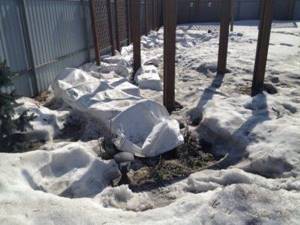
Geotextiles are one of the types of technical fabric used in agriculture.
Advantages of geotextiles:
- Cheapness. Covering a large area will be beneficial.
- Selling not only in rolls, but also in ready-made covers.
- Environmentally friendly.
- Breathability.
The stages of covering bushes with geotextiles are the same as with lutrasil.
What happens if you cover the bushes with snow?
Pros of covering with snow:
- Snow protects against temperature and wind fluctuations.
- A layer of snow will protect the plant from mice and hares.
- It will retain heat perfectly, protecting the plant from frost.
Minuses:
- Snow may fall later than the onset of cold weather.
- There is a high probability that it will melt in the middle of the season.
- Blown away by the wind.
- May become covered with a crust of ice and air flow will be interrupted.
How to cover:
- Prune the plant.
- Cover a little with earth with the addition of peat or humus.
- Cover with a large layer of snow.
- You can build a protective fence on top to prevent the snow from blowing away, exposing the ground, and with it the plants.
Straw protection
Pros of straw shelter:
- Perfectly protects from the cold.
- Capable of holding snow.
Minuses:
- Mice love to live in straw.
- She often whines and cakes.
- The ground under the straw does not thaw longer.
To build a straw house for rose bushes, you need to properly cover the cut roses with this material and wrap it with film on top.
We invite you to watch a video on how to cover roses with straw for the winter:
Using boards or plywood
Advantages of shelter made from boards or plywood : protection from low temperatures and high humidity.
How to cover:
- Make a hut from wooden shields.
- Cover the top with polyethylene.
Application of burlap
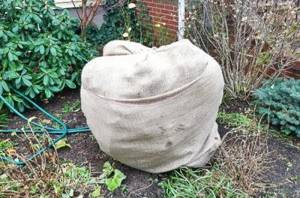
Pros of burlap:
- Natural materials breathe.
- There is excellent air exchange.
Minuses:
- The burlap absorbs moisture and becomes covered with ice.
- The plants are damping off.
- Old bags contain pathogens of various infections.
The bags are placed on top of the bush and tied with a strong, thick thread.
Protection from frost by plant stems
The essence of such a shelter is the same as in the version with straw. This method is suitable if nothing else is at hand.
How can peat help?
It should be noted that peat is an excellent heat insulator .
But it is more suitable for hilling before building a shelter.
Minuses:
- Absorbs moisture and becomes denser.
- Forms a crust when dry.
How to protect flowers from the cold with building materials and containers?
Boxes, cartons, blocks, slate, jars - all this is suitable for creating a shelter for rose bushes. Most often, such things are used as a frame and burlap is put on top or wrapped in film.
Minuses:
- Poor protection from cold.
- Possibility of containing chemical compounds.
- The plant may wither away.
How to cover floribunda roses for the winter
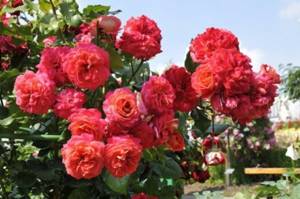
Although floribunda roses are easy to care for, they still require shelter for the winter. As with all shrubs, pre-winter fertilize with potassium-phosphorus fertilizers. In the fall, prune your roses. Old branches are cut out completely. On the main stem, the lateral shoots are shortened by removing leaves and inflorescences. Then hill up to a height of 30 cm. Cover with spruce branches and non-woven material on top.
Loosening and mulching
With the arrival of autumn, it is worthwhile to start weeding the rose garden. Remove all weeds and clear the surface of fallen leaves to prevent rotting and the spread of disease. This is preparatory work before subsequent mulching.
Loosening the soil should be stopped with the onset of cool weather.
Not the least important procedure for preparing roses for winter is mulching. It is very important to implement it in a timely and correct manner.
Experienced flower growers advise that before starting mulching, treat the bushes with special preparations or solutions to protect the flower beds from diseases and fungal infections. Tilling the garden should only occur in dry weather. Both foliage and soil at the roots are processed.

The rose can withstand short first temperature changes. But long frosts are destructive for the plant. At a stable temperature below -2°C it dies. Therefore, at the first frost, you need to start mulching the root collar. To do this, sprinkle the plant with dry soil near the soil. For different types, the height of the embankment varies:
- Low-growing varieties are mulched to a height of about 10 cm;
- For tall roses, the height of the mound should be up to 40cm.
In areas with unstable weather conditions and sudden constant changes in temperature, it is better to mulch with sand, as it dries faster and prevents the plant from rotting.
How to cover ground cover roses for the winter
Ground cover rose bushes generally tolerate wintering well without additional shelter. A month before the onset of frost, the last fertilizing with potassium-phosphorus fertilizer is carried out. Before the onset of frost, sanitary pruning should be carried out: remove weak and dried branches. Carry out disinfectant treatment with Bordeaux mixture. Ground cover varieties of roses are low-growing (50cm) shrubs; they are easiest to cover with spruce paws or any covering material.
Watering and fertilizing
In preparation for wintering the rose garden, the flowers are gradually stopped being enriched with nitrogen-based fertilizers, since the latter promote the formation of shoots. Due to weather conditions, new shoots do not have time to ripen before the first frost, as a result of which they freeze.
In the last months of summer, roses are fed with phosphorus-potassium fertilizers.
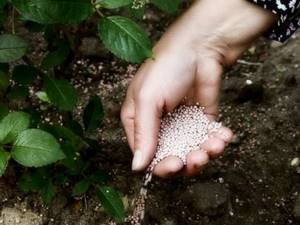
Ingredients for the first feeding:
- 25 g superphosphates;
- 2.5 g boric acid;
- 10 g potassium sulfate;
- 10 liters of water.
This extract should be enough to fully fertilize a 4 m2 rose garden.
With the onset of autumn, a second feeding is carried out with the following composition:
- 15 g superphosphates;
- 15 g of potassium monophosphates;
- 10 liters of water.
This solution can be used for both watering roses and foliar fertilization of foliage (spraying the bush).
For final processing, the concentration of the solution must be reduced by three times.
Granular fertilizers also provide roses with the necessary substances.
With the onset of autumn, it is also necessary to pay attention to the watering regime of flower beds. It should be moderate, as needed. In damp climates, flowers must be protected from excess moisture. As an example, plants can be covered with film.
An excess of moisture near the rhizome promotes the growth of shoots that will die when frost sets in. Also, plants can develop an aboveground root system. In winter, due to its vulnerability and accessibility, it can be damaged. All this will exhaust the bush, and with the arrival of the warm season, dried sprouts will appear in place of new green shoots.
It is possible to completely stop watering during heavy rainfall, since natural moisture is sufficient for the life of the plant.
In autumn, when the weather is dry, the plants need to be watered at least once every seven days. The amount of water consumed should be reduced by 3-5 liters (compared to summer watering). When cold weather sets in, watering is stopped.
Roses must go under the snow cover with a small supply of moisture, or they will begin to dry out. Seeing dried plants in the spring, novice flower growers, due to inexperience, think that they died due to frost, but this is wrong. The roses simply dried up under the hardened layer of earth.
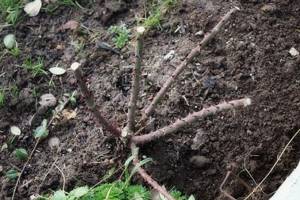
How to cover rose cuttings for the winter
The rose you like can be propagated by cuttings. And for this you need to save the cuttings until spring. To begin, select a strong, healthy shoot, at least 4 mm thick. Using a sharp knife, make a cut below the kidney at an angle (be sure to disinfect the knife). Leave the other end straight. We tear off all the leaves. We take wax or paraffin, heat it up and dip the ends, and then quickly cool it in water. That's it, the cuttings are prepared for wintering.
Next, choose a method of storing cuttings that is acceptable to you.
- Dig a trench in the garden 20 cm deep, the length of your cutting. At the bottom of the groove, place a layer of hay or non-woven material, cover it with insulation on top and cover it with earth. The main thing is that the cuttings lie separately from each other.
- Place the prepared cuttings in a box and sprinkle with sand. Store in a cold cellar or basement.
- It is very convenient to save cuttings on the loggia. Pour drainage into a box or box, pour soil for roses on top, add perlite and moisten the prepared mixture. The cuttings, pre-soaked in a growth stimulator, are planted in the soil. The container can be placed in a box and covered with a warm blanket or other insulation on top. The main thing is that they do not freeze. In warm weather, you can open it slightly, and if there is severe frost, you can bring it into the apartment.
Winter shelter of roses is a very important moment. Roses that are well covered in the fall may die in the spring from improper removal of the cover. In warm winters, there is damping off of the shoots; to prevent this from happening, drainage grooves for melt water must be made in March. When the snow melts, open the end walls of the shelters. This way you will save the life of your pets. Everything is very simple. The main thing is your desire.
Preparing roses for shelter correctly
Here are a few simple rules and tips that will help you avoid unpleasant surprises in the spring:
- Cutting flowers should stop in mid-August. Do not touch the buds until the plants are covered. In this case, the rose will not produce new shoots that will not have time to ripen before winter. The danger of their late appearance is that their freezing often leads to the death of strong, healthy branches of the previous order.
- In the first ten days of October, gardeners in central Russia need to clear rose bushes of foliage. There is an opinion that it should be preserved for a more comfortable wintering. But that's not true. The leaves must be plucked off, starting from the lower branches. They should then be removed away from the plants. Experienced gardeners recommend burning dry leaves, as spores of pathogenic fungi may remain on them.
- Do not feed roses in front of the shelter. You shouldn't do this in the middle of summer either. It is enough to feed plants of this type in spring or June. This will provide them with nutrients for the entire season.
- Do not cover roses ahead of time. This should be done only after the first frost. Despite the fact that the weather in central Russia in recent years has been unstable and full of surprises, and the first frosts may be severe, nothing bad will happen to the shoots and root system. But early covering of the bushes can lead to damping off of the roots.
Shelters for roses “Winter House”
What to look for in different regions?
When carrying out covering work in different regions of Russia, you need to pay attention to some nuances - in particular, at the time of the onset of a steady cold snap.
In the middle zone and Moscow region
In the conditions of the middle zone and the Moscow region, covering of rose bushes is carried out in the second ten days of October. First, all stages of preparing plants for winter are carried out, then they need to be covered with special structures and non-woven material stretched on top. Climbing varieties of roses are best covered with special tunnels. It is enough to cover park roses with fir branches.
In the south of Russia
In the southern Russian regions, these flowering perennials are usually not covered, since winters in these areas are quite warm.
In Siberia and the Urals
Although winters in Siberia and the Urals are quite severe, rose bushes in these regions do not require too complex shelter. It is enough to cover the trunk circles of this shrub with a layer of mulch 20-25 cm thick, and put spruce branches on top. When snow falls, it is shoveled onto the covered rose bushes.
If the winter is expected to be cold and snowless, a dry air shelter should be built on top of the spruce branches.











